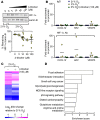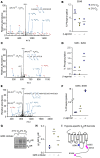Hypoxia sensing through β-adrenergic receptors
- PMID: 28018974
- PMCID: PMC5161214
- DOI: 10.1172/jci.insight.90240
Hypoxia sensing through β-adrenergic receptors
Abstract
Life-sustaining responses to low oxygen, or hypoxia, depend on signal transduction by HIFs, but the underlying mechanisms by which cells sense hypoxia are not completely understood. Based on prior studies suggesting a link between the β-adrenergic receptor (β-AR) and hypoxia responses, we hypothesized that the β-AR mediates hypoxia sensing and is necessary for HIF-1α accumulation. Beta blocker treatment of mice suppressed hypoxia induction of renal HIF-1α accumulation, erythropoietin production, and erythropoiesis in vivo. Likewise, beta blocker treatment of primary human endothelial cells in vitro decreased hypoxia-mediated HIF-1α accumulation and binding to target genes and the downstream hypoxia-inducible gene expression. In mechanistic studies, cAMP-activated PKA and/or GPCR kinases (GRK), which both participate in β-AR signal transduction, were investigated. Direct activation of cAMP/PKA pathways did not induce HIF-1α accumulation, and inhibition of PKA did not blunt HIF-1α induction by hypoxia. In contrast, pharmacological inhibition of GRK, or expression of a GRK phosphorylation-deficient β-AR mutant in cells, blocked hypoxia-mediated HIF-1α accumulation. Mass spectrometry-based quantitative analyses revealed a hypoxia-mediated β-AR phosphorylation barcode that was different from the classical agonist phosphorylation barcode. These findings indicate that the β-AR is fundamental to the molecular and physiological responses to hypoxia.
Conflict of interest statement
The authors have declared that no conflict of interest exists.
Figures






Similar articles
-
A(1) and A(3) adenosine receptors inhibit LPS-induced hypoxia-inducible factor-1 accumulation in murine astrocytes.Pharmacol Res. 2013 Oct;76:157-70. doi: 10.1016/j.phrs.2013.08.002. Epub 2013 Aug 19. Pharmacol Res. 2013. PMID: 23969284
-
Resveratrol inhibits hypoxia-inducible factor-1α-mediated androgen receptor signaling and represses tumor progression in castration-resistant prostate cancer.J Nutr Sci Vitaminol (Tokyo). 2014;60(4):276-82. J Nutr Sci Vitaminol (Tokyo). 2014. PMID: 25297617
-
HIF-1α and HIF-2α are critically involved in hypoxia-induced lipid accumulation in hepatocytes through reducing PGC-1α-mediated fatty acid β-oxidation.Toxicol Lett. 2014 Apr 21;226(2):117-23. doi: 10.1016/j.toxlet.2014.01.033. Epub 2014 Feb 3. Toxicol Lett. 2014. PMID: 24503013
-
The role of nitric oxide (NO) in stability regulation of hypoxia inducible factor-1alpha (HIF-1alpha).Curr Med Chem. 2003 May;10(10):845-55. doi: 10.2174/0929867033457746. Curr Med Chem. 2003. PMID: 12678687 Review.
-
Vasculogenesis and angiogenesis initiation under normoxic conditions through Wnt/β-catenin pathway in gliomas.Rev Neurosci. 2018 Jan 26;29(1):71-91. doi: 10.1515/revneuro-2017-0032. Rev Neurosci. 2018. PMID: 28822229 Review.
Cited by
-
Yes-associated protein (YAP) and transcriptional coactivator with a PDZ-binding motif (TAZ): a nexus between hypoxia and cancer.Acta Pharm Sin B. 2020 Jun;10(6):947-960. doi: 10.1016/j.apsb.2019.12.010. Epub 2019 Dec 19. Acta Pharm Sin B. 2020. PMID: 32642404 Free PMC article. Review.
-
Adrenergic-Angiogenic Crosstalk in Head and Neck Cancer: Mechanisms and Therapeutic Implications.Front Oral Health. 2021 Jun;2:689482. doi: 10.3389/froh.2021.689482. Epub 2021 Jun 8. Front Oral Health. 2021. PMID: 34790909 Free PMC article.
-
GRK2-Dependent HuR Phosphorylation Regulates HIF1α Activation under Hypoxia or Adrenergic Stress.Cancers (Basel). 2020 May 13;12(5):1216. doi: 10.3390/cancers12051216. Cancers (Basel). 2020. PMID: 32413989 Free PMC article.
-
Impairment of Hypoxia-Induced CA IX by Beta-Blocker Propranolol-Impact on Progression and Metastatic Potential of Colorectal Cancer Cells.Int J Mol Sci. 2020 Nov 19;21(22):8760. doi: 10.3390/ijms21228760. Int J Mol Sci. 2020. PMID: 33228233 Free PMC article.
-
The pVHL neglected functions, a tale of hypoxia-dependent and -independent regulations in cancer.Open Biol. 2020 Jul;10(7):200109. doi: 10.1098/rsob.200109. Epub 2020 Jul 1. Open Biol. 2020. PMID: 32603638 Free PMC article. Review.
References
Grants and funding
LinkOut - more resources
Full Text Sources
Other Literature Sources
Molecular Biology Databases
Research Materials

